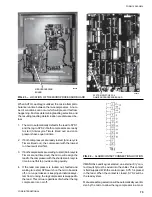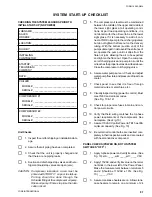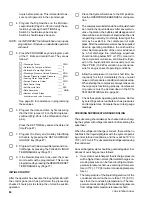
FORM 150.65-NM4
83
YORK INTERNATIONAL
The subcooling temperature should be taken by record-
ing the temperature of the liquid line at the outlet of the
condenser and recording the liquid line pressure at the
liquid stop valve with the system fully loaded after steady
state operation has been established and converting it
to temperature from a temperature/pressure chart. Be
sure to insulate the thermometer or thermocouple at-
tached to the piping.
Example:
LIQUID LINE PRESSURE
202 PSIG converted to
102°F
Minus Liquid Line Temperature - 90°F
Subcooling =
12°F
Record: SYS 1______, SYS 2______
The proper refrigerant charge is attained when subcooling
is measured at 10 - 15°F (-12.2 to -9.4°C). Add charge
as needed to increase subcooling and remove charge as
necessary to reduce subcooling. Whenever removing
charge, be sure to recover it in an approved container.
After the subcooling is set at 10 - 15°F (-12.2 to -9.4°C)
by adding or removing charge and steady state fully loaded
operation is established, system superheat should also
be adjusted for 10 - 15°F (-12.2 to -9.4°C). A factory rec-
ommended superheat setting of 15°F (-9.4°C) is appropri-
ate for systems that operate over a variety of ambient
temperatures, chilled liquid temperatures, and loading
conditions. It also compensates for gauge and tempera-
ture sensor inaccuracy. When measuring superheat, be
sure to insulate a thermometer or thermocouple attached
to the piping to assure a true temperature is measured.
The superheat is the difference between the actual tem-
perature of the returned refrigerant gas entering the com-
pressor and the temperature corresponding to the suc-
tion pressure as shown in a standard pressure/tempera-
ture chart. The suction temperature should be taken 6"
before the compressor service valve, and the suction pres-
sure is taken at the compressor suction service valve.
Example:
Suction Temperature
46°F
Minus Suction Pressure - 56 PSIG
Converted to Temperature
- 31°F
Superheat =
15°F
Superheat SYS 1 ____, SYS 2 ____
Normally, the thermal expansion valve need not be ad-
justed in the field. If, however, an adjustment is to be
made, the expansion valve adjusting screw should be
turned not more than one turn at a time, allowing suffi-
cient time (approximately 15 minutes) between adjust-
ments for the system and the thermal expansion valve
to respond and return to settled operation.
Proper subcooling and superheat will assure optimum
performance and reliability of the system. Checks should
always be made when commissioning a chiller and on a
yearly basis.
If the unit has been functioning satisfactorily during the
initial operating period, it is ready for continuous opera-
tion.
'
Leak check compressors, fittings, and piping to
assure no leaks are present from improper handling.
OPERATING SEQUENCE UTILIZING
RETURN WATER CONTROL
NOTE: The operating sequence described below relates
to operation after power has been applied on a
hot water start such as startup commissioning
or a hot water start at the beginning of the day.
It also assumes that 10 steps of loading are
available and programmed. If less than 10 steps
are available, no chiller response will take place
at some of the operating points described.
1.
For the system compressors to run, all Manual
Reset Cutouts must be reset, the Flow Switch
must be closed, the System Switches must be
ON, the Daily Schedule must be scheduling the
chiller to run, and temperature demand must be
present.
2.
As long as power is applied, the Crankcase Heat-
ers will be on and stay on as long as the com-
pressors are not running.
3.
If power has just been applied to the system, the
microprocessor will start a 2 minute timer. This is
the same timer that prevents an instantaneous
start after a power failure.
NOTE: Compressor Crankcase Heaters should
be on for a period of 24 hours prior to
commissioning. Failure to allow the
heater sufficient time to warm the oil may
damage the compressor due to liquid re-
frigerant in the oil.
4.
At the end of the 2 minute timer, the micropro-
cessor will check for cooling demand as well as
check to see if any system safeties have been
exceeded. If all conditions allow for start, the lead
compressor will start unloaded. Coincident with
the start, the programmable anti-recycle timer will
be set and begin counting downward to “0”. The
liquid line solenoid of the compressor will open.
Содержание Millennium YCAJ150
Страница 21: ...FORM 150 65 NM4 21 YORK INTERNATIONAL LD02461 FIG 6 ELEMENTARY DIAGRAM Cont d...
Страница 22: ...22 YORK INTERNATIONAL ELEMENTARY DIAGRAM...
Страница 24: ...24 YORK INTERNATIONAL CONNECTION DIAGRAM FIG 7 CONNECTION DIAGRAM LD02463...
Страница 25: ...FORM 150 65 NM4 25 YORK INTERNATIONAL FIG 7 CONNECTION DIAGRAM Cont d LD02462...
Страница 26: ...26 YORK INTERNATIONAL CONNECTION DIAGRAM TERMINAL BOX AND SYSTEM WIRING FIG 8 SYSTEM WIRING LD02464...
Страница 28: ...28 YORK INTERNATIONAL CONNECTION DIAGRAM TERMINAL BOX AND SYSTEM WIRING FIG 8 SYSTEM WIRING Cont d LD02650...
Страница 30: ...30 YORK INTERNATIONAL FIG 8 SYSTEM WIRING Cont d LD02499...
Страница 100: ...100 YORK INTERNATIONAL LD02654 FIG 37B LOUVER BRACKETS INSTALLATION...
Страница 101: ...FORM 150 65 NM4 101 YORK INTERNATIONAL LD02655 FIG 37C GRILLE AND LOUVER INSTALLATION FRONT AND BACK...
Страница 103: ...FORM 150 65 NM4 103 YORK INTERNATIONAL LD02656 FIG 39A LOUVER INSTALLATION SIDES...
Страница 104: ...104 YORK INTERNATIONAL LD02654 FIG 39B LOUVER BRACKETS INSTALLATION...
Страница 105: ...FORM 150 65 NM4 105 YORK INTERNATIONAL LD02657 FIG 39C GRILLE AND LOUVER INSTALLATION FRONT AND BACK...
Страница 107: ...FORM 150 65 NM4 107 YORK INTERNATIONAL FIG 40A CONDENSER COIL LOUVER INSTALLATION SIDES LD02658...
Страница 108: ...108 YORK INTERNATIONAL FIG 40B CONDENSER COIL LOUVER INSTALLATION FRONT AND BACK LD02659...
Страница 110: ...110 YORK INTERNATIONAL FIG 41 REMOTE RESET BOARD LD02666 P1...






























